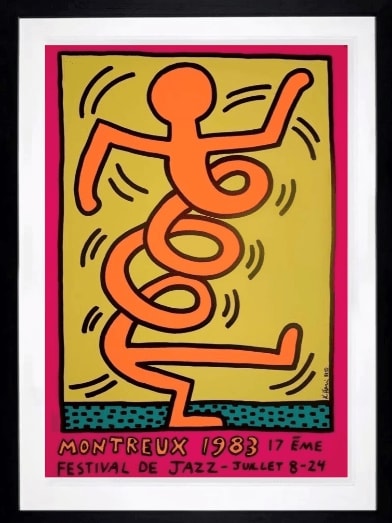Keith Haring
100 x 70 cm
Keith Haring (1958–1990)
Poster for Montreux Jazz Festival 1983 (Pink, Yellow and Orange)
Neon Screenprint on wove, 1983 From the unnumbered, unsigned edition (there was also an signed edition of 80)
Printed by Serigraphie Uldry Bern, Switzerland Sheet: 1000 x 700 mm (39 ⅖ x 27 ⅗ in)
Literature (Littmann p.24-27)
Keith Haring began his art career on the New York subways as a street artist, but was also highly interested in producing commercial artworks for the public. As a result Haring produced many screen-prints, lithographs, etchings and posters which became integral to his artistic career along side his street works.
The first official exhibition of Haring’s work was held in 1982 at the Tony Shafrazi Gallery in New York, and was hugely successful. Pierre Keller met Haring a few months later and asked him to produce a Festival poster featuring a dancing figure. Haring came up with three designs, all of which were accepted to mark the occasion of the Montreux Jazz Festival, held in Lake Geneva in July 1983. Keller and Nobs had the brainwave of inviting the New York artist to Montreux. As always, Haring painted constantly, producing murals on large blank panels on stage with the musicians and in the streets of Montreux.
In the present work, we see Haring’s iconic lively figure of a ‘dancer’ with a spiralised from and contrasting angles. The signature black outline forms a bold contrast against the energetic colours and alluding to the movement of the dancer. These posters include a printed date and signature, aligned vertically along the right-hand side of the inner border.
In 1986 Haring returned to this subject for creating a poster for the festival collaborating with Andy Warhol.
Haring was a prominent artist and social activist known for his distinctive style and iconic imagery. His public artworks, including the painting on the Berlin Wall in 1986, served as powerful expressions of his beliefs and advocacy for various social causes such as LGBT rights and the Safe Sex campaign.
Haring's artworks often carried deeper messages beneath their seemingly playful and colourful exterior, addressing themes of conflict, mortality, and social issues. His work reflected the sombre realities of the time, particularly the devastating impact of the AIDS epidemic, which tragically claimed his life at a young age.
One of the remarkable aspects of Haring's art was its accessibility and universal appeal. His graphic works, including posters, transcended traditional boundaries between high art and street art, making them relatable to a wide audience. Haring's use of figurative language and symbolic imagery allowed him to communicate his message effectively, with lettering often taking a backseat to the visual elements.
Haring's posters, in particular, played a significant role in projecting his voice within the community and spreading awareness about social issues. Over time, these posters have gained recognition as valuable collectibles, reflecting the enduring impact of Haring's artistic legacy.
Through his art and activism, Keith Haring left a lasting impression on the art world and continues to inspire generations with his innovative approach to blending art and social commentary.
Would you like us to stay in touch?
* denotes required fields
We will process the personal data you have supplied in accordance with our privacy policy (available on request). You can unsubscribe or change your preferences at any time by clicking the link in our emails.



